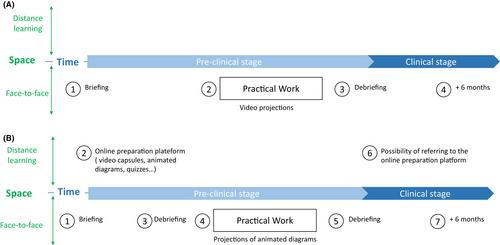Blended learning compared to traditional learning for the acquisition of competencies in oral surgery by dental students: A randomized controlled trial
Abstract
Objective
To determine whether blended learning results in better educational outcomes compared to traditional learning in the acquisition of oral surgery technical skills for 4th-year undergraduate dental students.
Materials and Methods
Seventy-three students participated in this two-arm parallel randomized controlled trial. Only students in the blended learning group had access to the online preparation platform for oral surgery practical work (PW) on a pig's jaw and to the debriefing. Kirkpatrick's four-level model was used to assess the educational outcomes directly after (levels 1 and 2) and 6 months later, after the start of the students' clinical activity (levels 3 and 4).
Results
For level 1, higher global satisfaction scores were found for students in the blended learning compared to the traditional learning group (p = .002). For level 2, blended learning resulted in an increase in knowledge score (p < .01), comparable to that observed in the traditional learning group. For level 3, students in the blended group made more progress in 6 months than those in the traditional group in terms of feeling able to assess and perform anaesthesia (p = .040) and surgical tooth extraction (p = .043). No difference in level 4 was found for the 6-month clinical surgical activity between groups, but students in the blended group felt more able to assess and perform the surgical management of a failed extraction requiring bone removal (p = .044).
Conclusion
Blended learning for oral surgery PW had a positive impact on three of the four Kirkpatrick levels (level 1, 3 and 4). Efforts should focus on the procedures that are perceived as the most difficult.


 求助内容:
求助内容: 应助结果提醒方式:
应助结果提醒方式:


